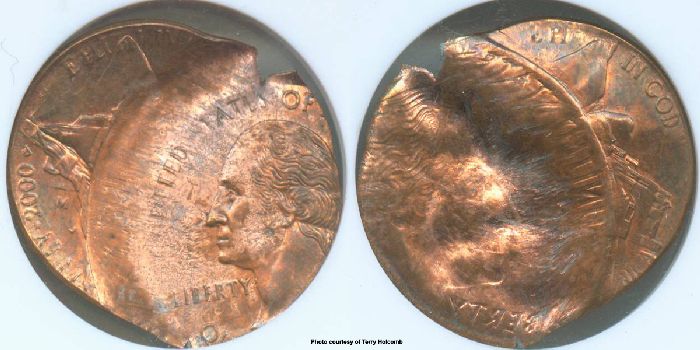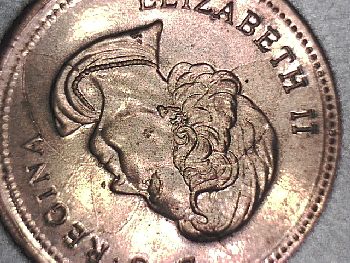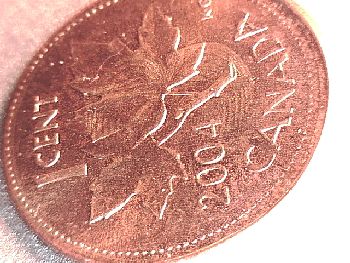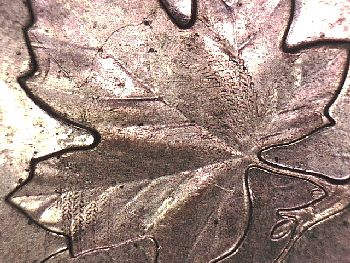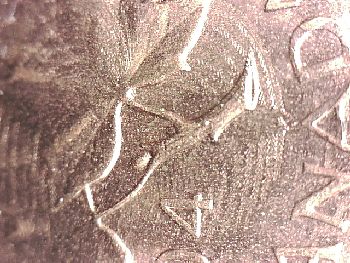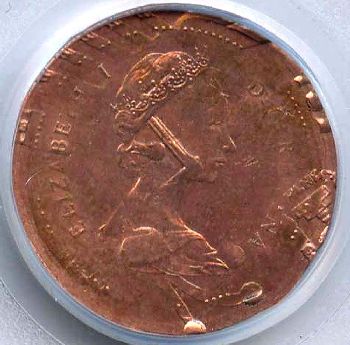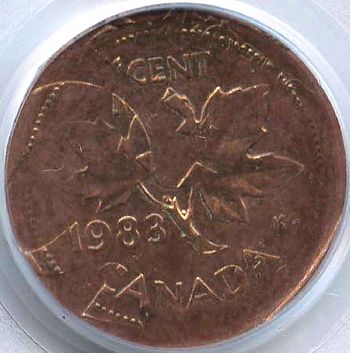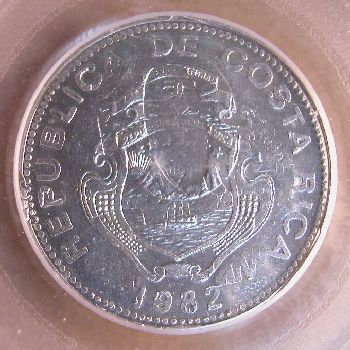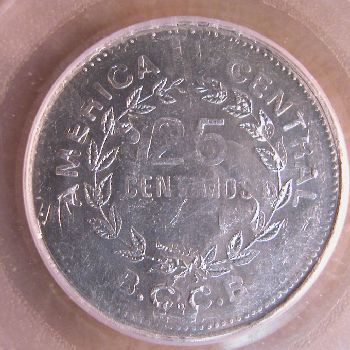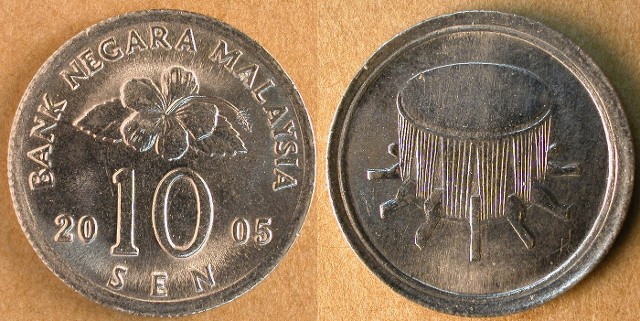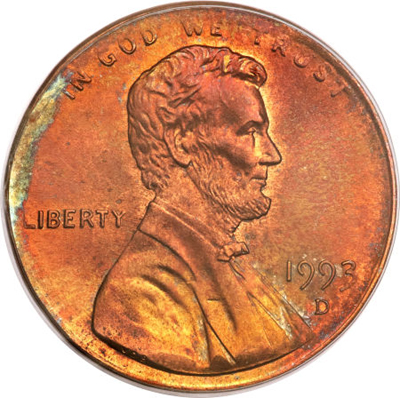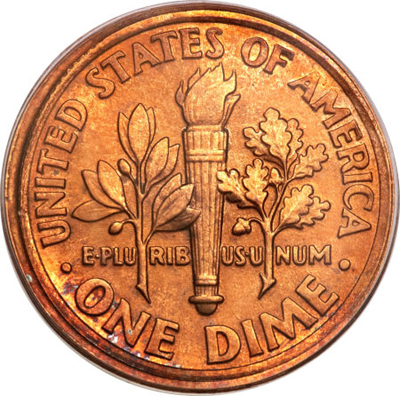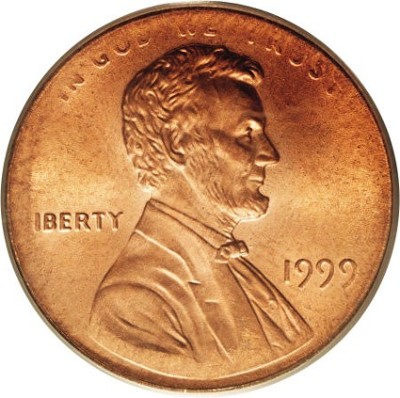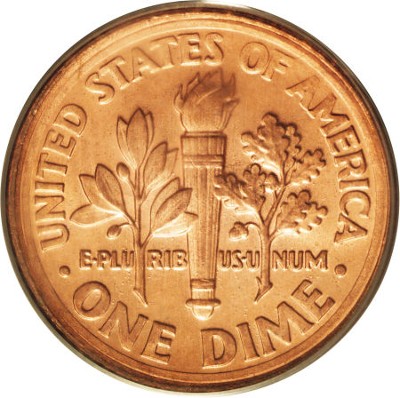PART VI. Planchet Errors:
Split Planchet:
After Strike:
Wrong Denominational Planchet / Off-metal:
Definition:A coin was struk on the wrong denominational planchet and split after the strike.
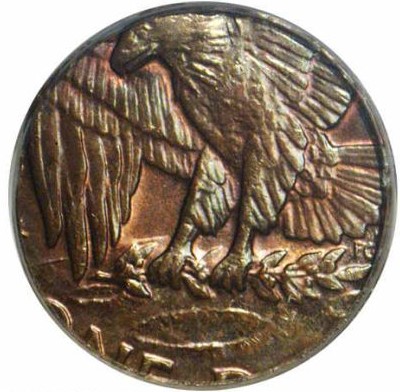 |
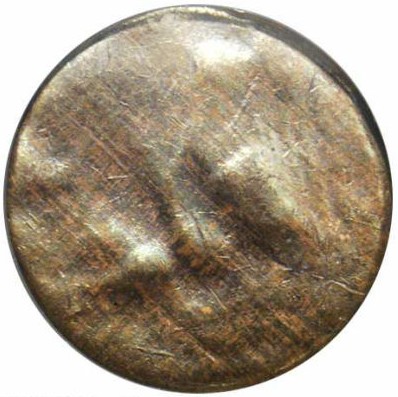 |
|
A cent planchet found its way between Eisenhower dollar dies and was struck. After the strike, the coin split in two along its edge. The half coin pictured above, shows a partial reverse design along with a uniface “obverse”. Images are courtesy of Heritage Auctions. |
Wrong Ring
Part V. Planchet Errors:
Bimetallic Errors:
Wrong ring
Definition: A bimetallic planchet that is assembled using the correct core but the wrong ring. Bi-metallic error coins are restricted to foreign countries. These coins may experience any of the many types of striking errors listed in the Error-Variety Ready Reference however, one must understand we are dealing with two components, a ring and a core. Any number of exotic possibilities or combinations of die varieties, die errors, planchet errors and striking errors can be found on bi-metallic coinage. These errors are unequivocally rare.
There are any number of sources for the incorrect ring.
- It might be a ring that was intended for a different bimetallic denomination
with a similar-sized hole. - Punched out of stock intended for a different bimetallic denomination.
- Punched out of stock intended for a solid-alloy denomination.
- Punched out of stock intended for the core.
- An inadvertently holed, solid-alloy blank or planchet intended for another
denomination. - A previously-struck, solid alloy coin that was accidentally holed.
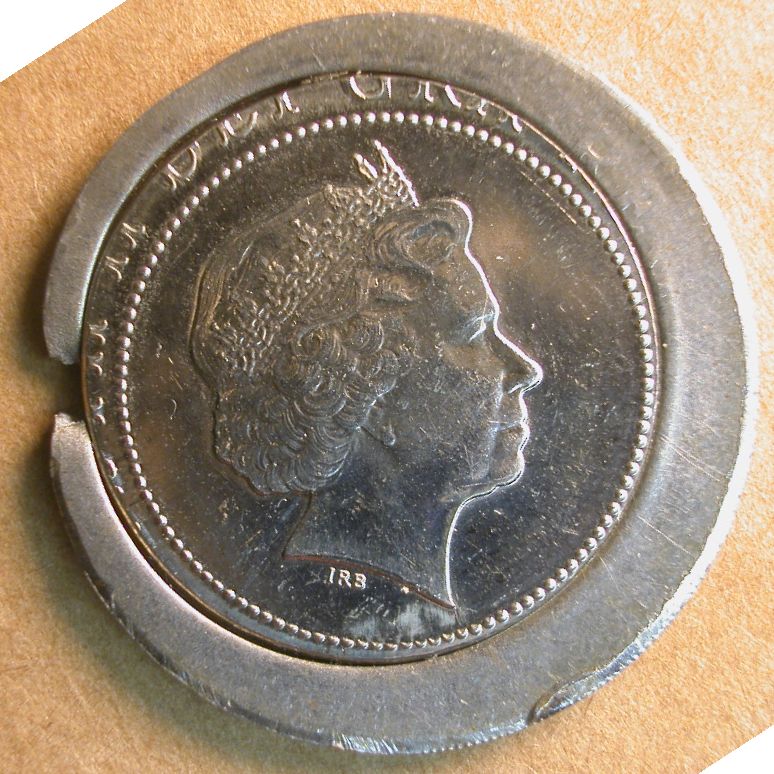
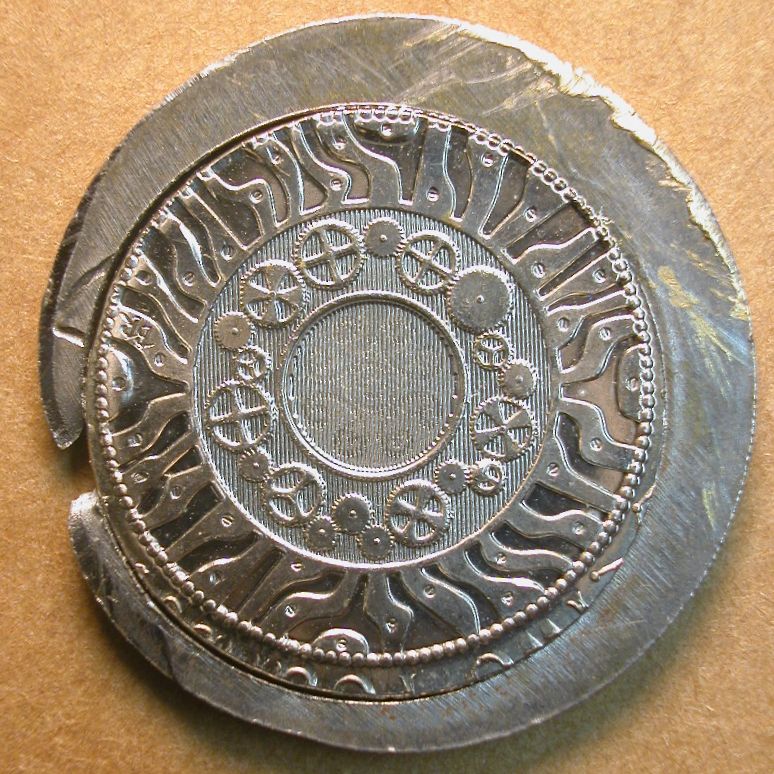
This 2001 British 2 pound coin has a normal copper-nickel core surrounded by a steel ring instead of the expected nickel-brass ring. The steel ring is substantially thinner than both the core and normal ring, which is why so few peripheral design elements appear on it. The steel ring weighs an estimated 2.6 grams instead of the normal 5.9 grams. The edge of the off-metal ring displays a few letters of “ON THE SHOULDERS OF GIANTS”. This shows that the composite disc passed through the appropriate edge-lettering device and that its original external diameter was close to that of an assembled 2 pound blank.
The center hole was presumably punched to normal diameter, since British 2 pound bi-metallic blanks are pre-assembled. The hole’s offset position may be partly due to the slightly undersized steel disc occupying an uncentered position within the hole-punching device. The offset appearance was accentuated by uneven expansion of the core during the strike, which split the ring at 9:00.
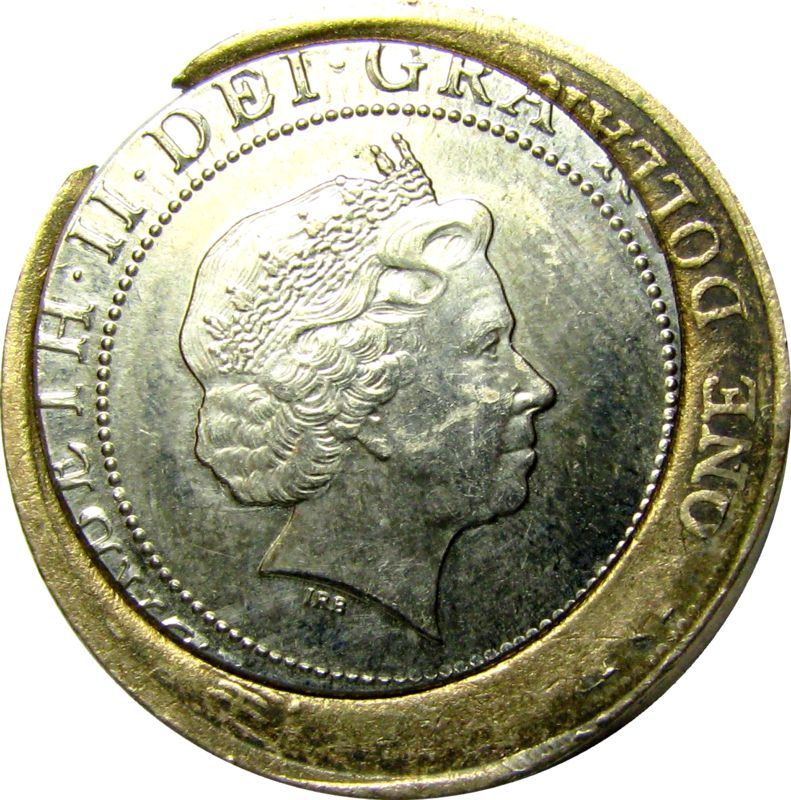
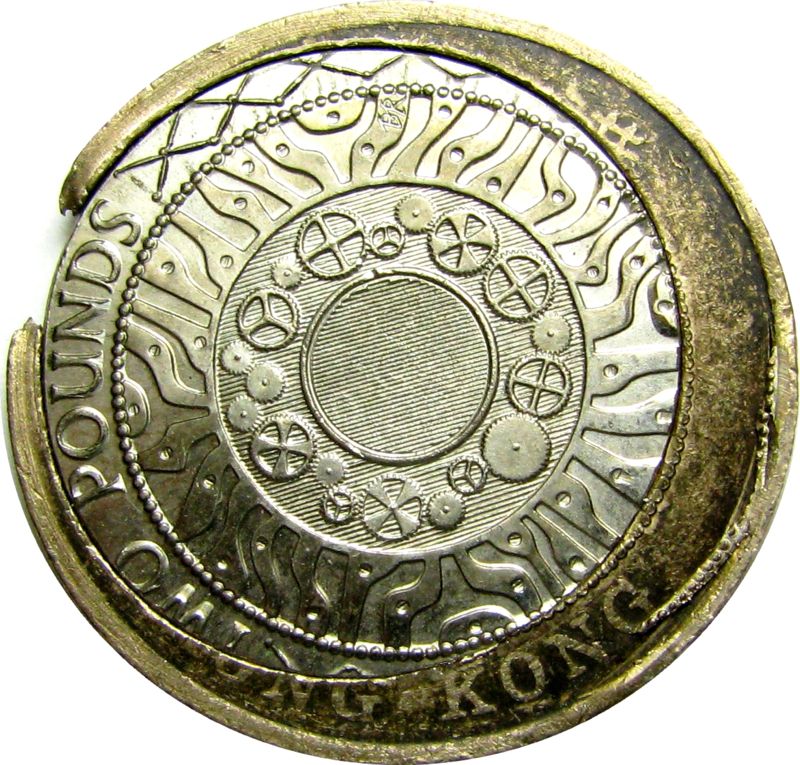
The ring on this British 2 pound coin was derived from a worn, battered, and discolored Hong Kong dollar (1993-1998). Composed of a solid copper-nickel alloy, this coin had its center punched out and filled with a British 2 pound core. A misaligned hole, combined with uneven expansion of the core, caused the ring to split at 10:30 when it was struck by the 2 pound dies. The edge of the ring carries no edge lettering. It either bypassed the edge lettering device or was too small to betray its passage through the device.
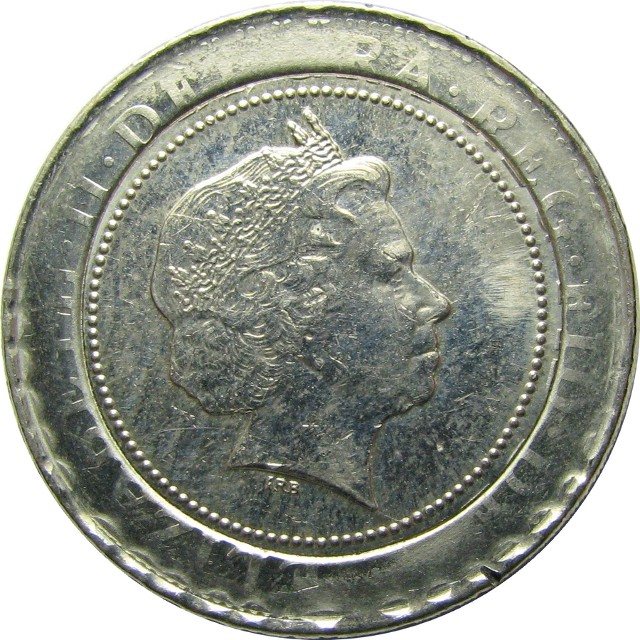
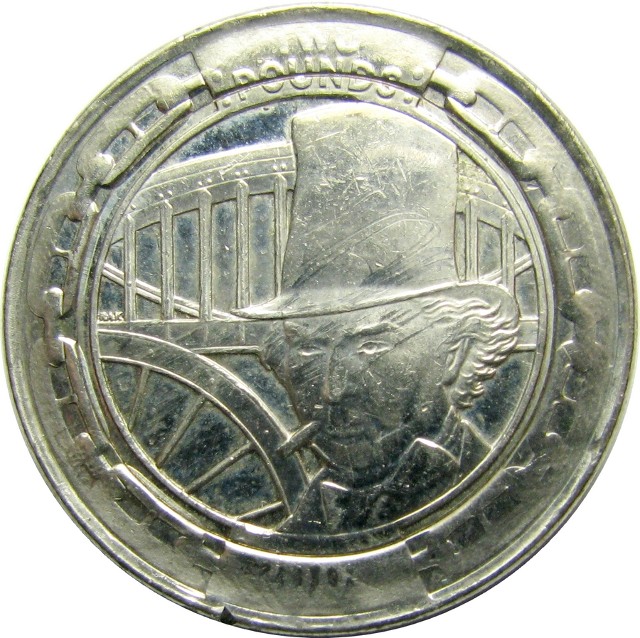
A two pound 2006 Isambard Brunnel from Great Britain. The ring is is strongly attracted to a magnet. (Either elemental nickel or steel composition). Weight: 10.30 grams.
Note the following specification information regarding U.K. outer rings: 12.0 g is normal weight for a bi-metallic of this series. A two pound ring consists of the following composition and weight: Two pound ring 76% Copper, 4% Nickel, 20% Zinc Weight – 6.0 g
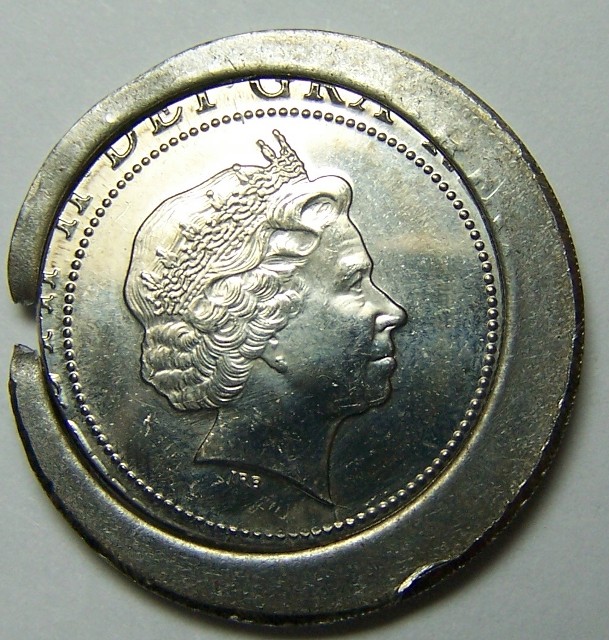
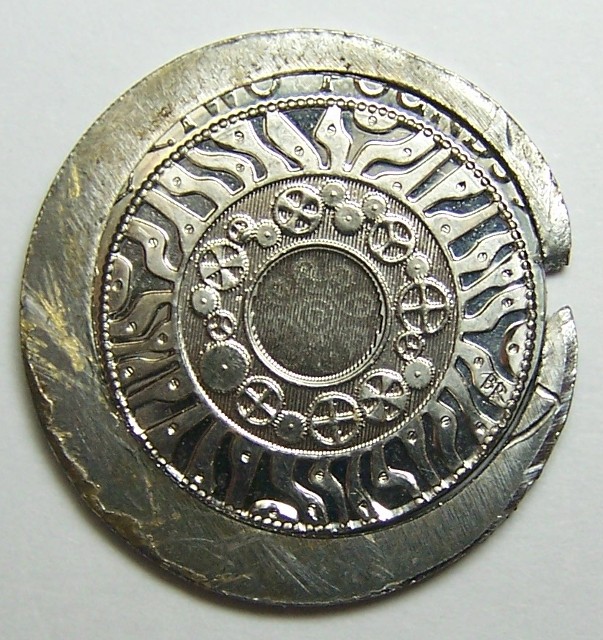
A two pound Technology from Great Britain. Ring is strongly attracted to a magnet (steel ring). The ring also has a misaligned center hole. The ring is much thinner than the core resulting in the near incomplete absence of design transfer on either face of the ring. The ring also sheared & snapped when struck.
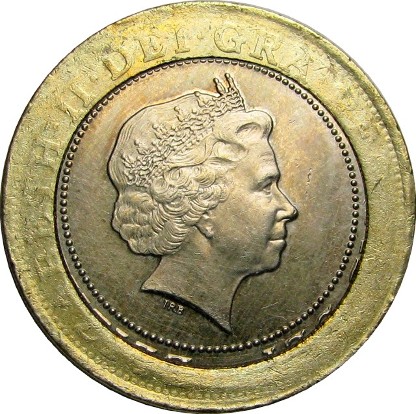
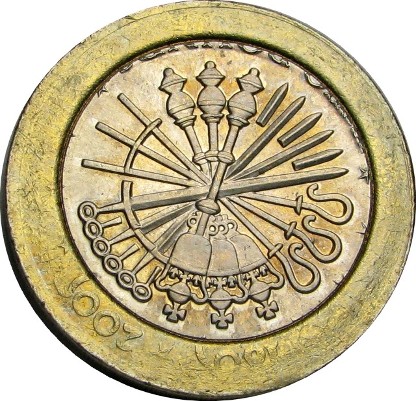
A two pound 2007 Gun Powder Plot from Great Britain with wrong ring. The ring also has a misaligned center hole. The ring is thinner than the core resulting in the absence of some design transfer on either face of the ring.
Struck Over Pre-Existing Wrong Planchet/Off-Metal Error
Part V. Planchet Errors:
Wrong Planchet and Off-Metal Errors:
Double Denomination Errors:
Struck Over Pre-Existing Wrong Planchet/Off-Metal Error
Definition: A design struck over another design (either domestic or foreign) which was, in turn, struck on the wrong planchet. Such errors are quite rare, with a significant proportion intentionally fabricated inside the mint.
This state quarter design was struck over a 2000-P nickel design which had been, in turn, struck twice on a cent planchet. The quarter strike was off-center and has a first-strike brockage of the obverse quarter design on its reverse face. This error may have had some assistance in its creation. Photos courtesy of Terry Holcomb.
This 2004 Canadian cent design was struck over a 2004 Papua New Guinea 1 tohea design which had itself been struck on a Fiji one cent planchet. The coin was cherrypicked from eBay by James Zimmerman, who expended a great deal of time and effort in identifying the host coin design and the original purpose of the planchet. This seems to be a truly accidental error. Photos courtesy of James Zimmerman.
This 1983 Canadian cent design was struck on an Israel 10 shekels design which was originally struck on a Canadian 1 cent planchet. As such, the final strike generated a dual country / double-denomination error but not a wrong planchet error. This is almost certainly an intentional error because it was struck in-collar. The original off-metal coin would have to have been resized after the first strike, which would have caused the coin to expand beyond the diameter of the collar. Photos courtesy of Fred Weinberg.
This 1982 Costa Rica 25 centavos design was struck over an Israel 10 shekels design which had originally been struck on a Costa Rica 25 centavos planchet. As with the previous coin, the final strike generated a dual country/double denomination error but not a wrong planchet error. And as with the previous coin, the last strike was in-collar, which would have required resizing of the expanded off-metal 10 shekels. Photos by Mike Diamond
Wrong Planchet And Off Metal Errors
PART V: Planchet Errors:
Wrong Planchet and Off Metal Errors
Definition: A wrong planchet error is exactly what the name indicates – a coin struck on a planchet intended for another denomination (domestic or foreign). The incorrect planchet may have the same composition (e.g. a quarter struck on a dime planchet) or it may be a different composition (e.g., a quarter struck on a nickel planchet).
An off-metal error is a coin struck on a planchet whose composition does not match the composition that normally characterizes the coin. While off-metal errors can be wrong planchet errors, this is not always the case. For example, a dime struck on a copper core is off-metal but is not really a wrong planchet.
The coin below is both a wrong planchet and an off-metal error. It is a Monroe Dollar struck on a dime planchet.
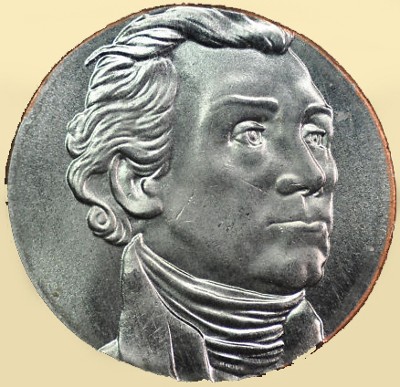
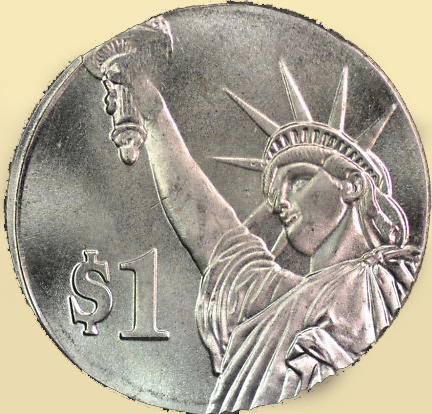
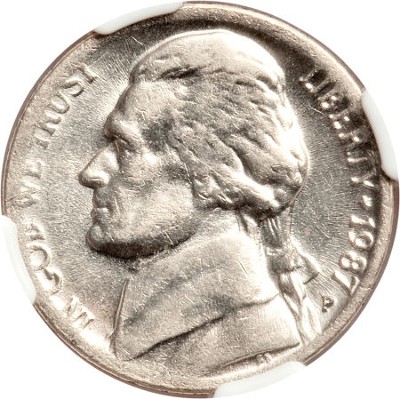
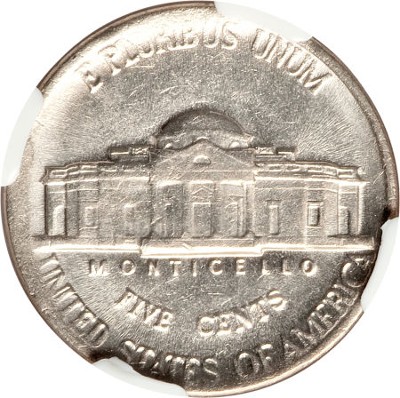
.
A Sacagawea planchet somehow found its way into the coin press that was striking 1999-P Susan B. Anthony dollars.
This coin is comes to us courtesy of Mark Lighterman
Images were taken through an encapsulation.
Wrong Stock: Off Metal
Part V: Planchet Errors:
Wrong Stock:
Off-Metal
Definition: A wrong stock error emerges when coin metal strip intended for one denomination is sent through a blanking press punching out blanks for another denomination. The resulting blanks end up with the design and denomination appropriate for the size of the blank. An example of such an error would be a half dollar struck on quarter dollar stock.
The vast majority of wrong stock errors do not involve a change in the coin’s composition. A quarter dollar struck on dime stock will still have a normal copper-nickel clad composition.
Wrong stock errors involving strip of the wrong composition are very rare. Why this is so is rather obvious. It’s easy to switch coils of metal that are identical in every respect except thickness. But when the stock has a different color on its surface or edge, that difference is hard to miss.
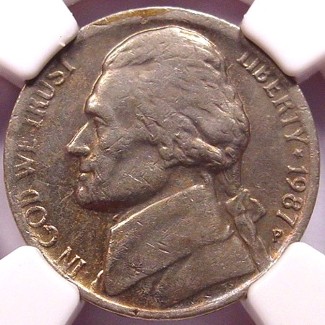
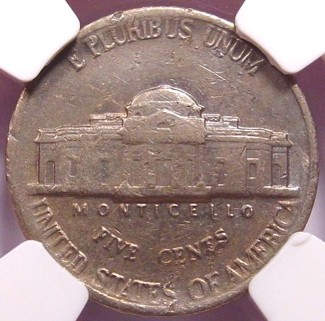
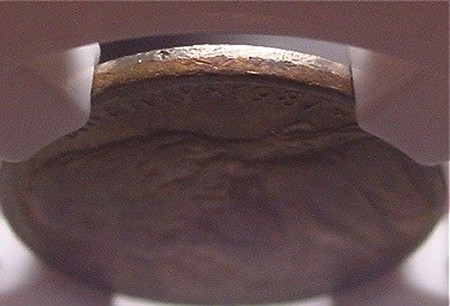
The best-known off-metal, wrong stock error is a 1987-P nickel struck on copper-nickel clad quarter stock. The
illustrated coin and the small number of other known specimens weigh around 4.2 grams, which is exactly what you’d predict given the thinner cross-sectional profile of the quarter strip. Photos courtesy of Jon Sullivan
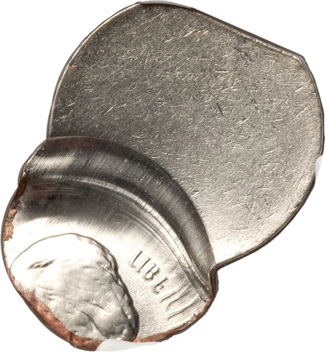
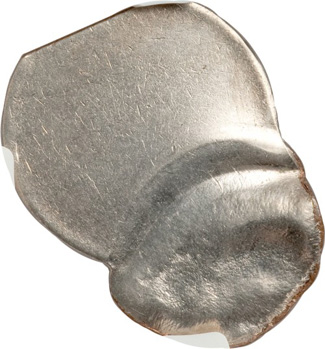
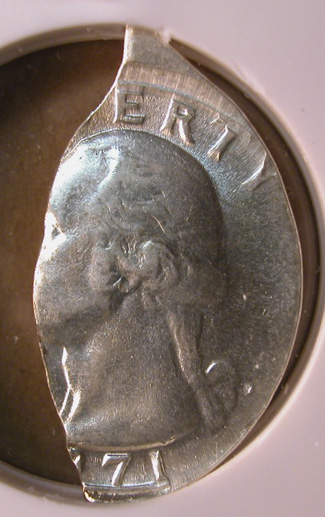
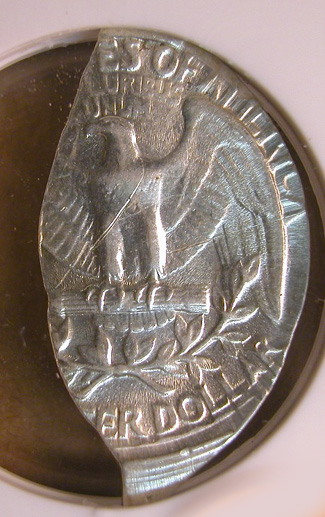
Photos courtesy of Heritage Auctions.
This 1971-D quarter was struck off-center on a quarter-sized silver-clad planchet with a large straight clip. According to NGC, it weighs 2.4 grams. The composition is said by NGC to be 80% silver and 20% copper. It is assumed that this is just a measurement of the surface composition. This ratio of metal is found only in the clad layers of half dollars minted between 1965 and 1970. However it also appears in the clad layers of half dollar-size Panama 1/2 balboas produced by the San Francisco Mint between 1967 and 1975.
The planchet is indeed silver-clad, with clad layers composed of 80% silver and 20% copper. A darker core is visible which is presumably composed of 79% copper and 21% silver. As in typical silver-clad half dollars, the exposed core appears gray.
The planchet upon which this coin is struck is no thicker than a quarter; therefore this is not simply obsolete half dollar stock. It would appear that a coil of silver-clad strip intended for 1970-D half dollars was mistakenly rolled to quarter thickness, labeled quarter stock, and then stored away with normal copper-nickel clad quarter strip. Then, in 1971, the off-metal strip was retrieved from storage, sent through a blanking press punching out quarter blanks, and the rest is history. The presence of the straight clip indicates that this planchet is probably derived from the leading end of the strip. Since this is a unique specimen, I suspect someone quickly realized the mistake and stopped the blanking press before the strip could progress very far.
While it’s possible that contemporarily 1/2 balboa strip was reduced to quarter dollar thickness, I view this as less likely since the 1/2 balboa coins were struck in San Francisco and because this coin was struck only one year after cessation of silver-clad half dollar production. In 1970, only the Denver Mint was producing half dollars, and these were restricted to mint sets.
Mules Wrong Anvil Die
PART III. Die installation Errors:
Mules:
Wrong anvil die
Definition: Mules are coins struck by mismatched dies. In this case the wrong anvil die was installed in a coin press.
This Malaysian 10 sen mule was struck on a 10 sen planchet in a reeded 10 sen collar and carries a normal 10 sen obverse. The reverse face was struck by a 1 sen reverse (anvil) die.
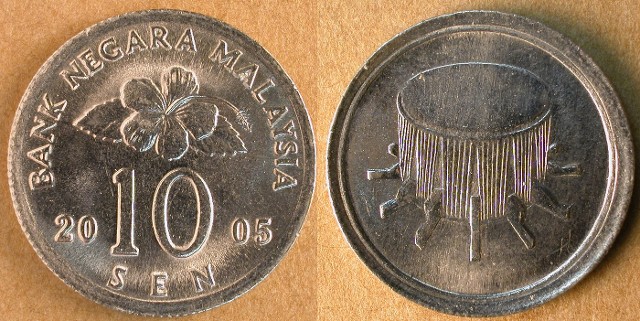
This dual denomination mule was struck in 1993 by the Denver mint. It had the correct hammer die (cent die) and the coin was struck on the correct planchet. However, the anvil die (dime die) was mistakenly installed in the coin press which resulted in this unique combination.
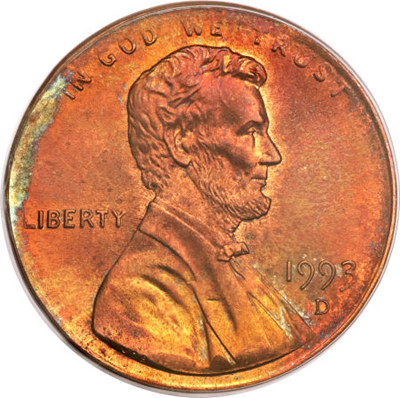
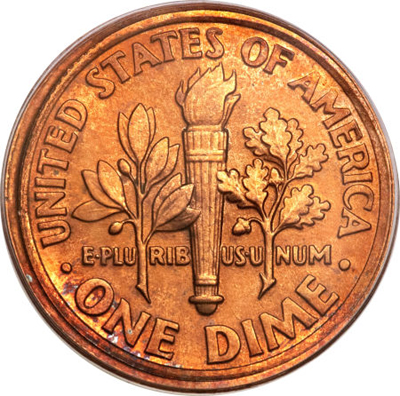
This dual denomination mule coin was struck in 1999 by the Philadelphia mint. It had the correct hammer die (cent die) and the coin was struck on the correct planchet. However, the anvil die (dime die) was mistakenly installed in the coin press which resulted in this unique combination.
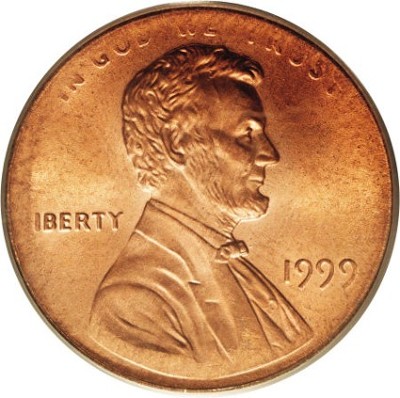
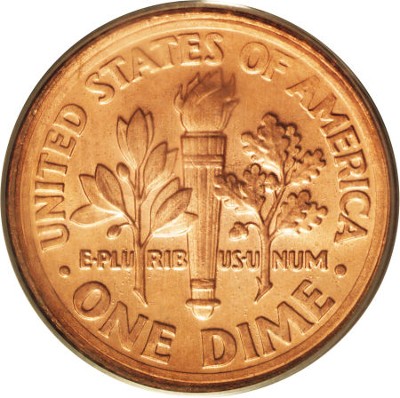
Images courtesy of Heritage Auctions
Mules Wrong Hammer And Anvil Die
PART III. Die Installation Errors:
Mules:
Wrong hammer and anvil die
Definition: Mules are coins struck by mismatched dies. In this case both hammer and anvil dies were not correct.
This Malaysian mule would be classified as a “double mule” It was struck by a 1 sen obverse die and a 1 sen reverse die installed in a 10 sen press. The coin was struck on a copper-nickel 10 sen planchet inside a 10 sen collar and shows the reeded edge normal for the 10 sen denomination (the 1 sen coin has a smooth edge).
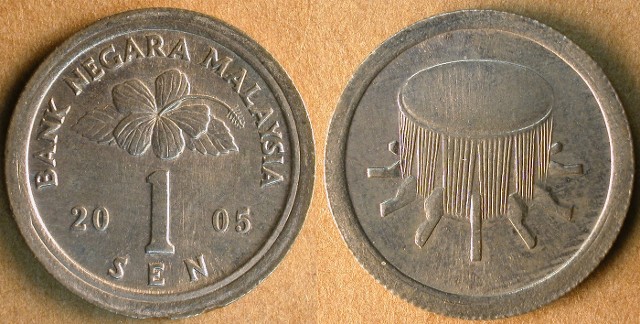
Mules Wrong Hammer Die
PART III. Die Installation Errors:
Mules:
Wrong hammer die
Definition: Mules are coins struck by mismatched dies. In this case, the wrong hammer die was installed in a coin press.
The 2005 Malaysian mule shown below was struck on a copper-nickel 10 sen planchet inside a reeded 10 sen collar and features a normal 10 sen reverse design. The obverse (struck by the hammer die) shows an unexpected and appreciably smaller 1 sen design. This resulted in a weakly struck periphery on the reverse face. A normal 1 sen coin is copper-plated steel.
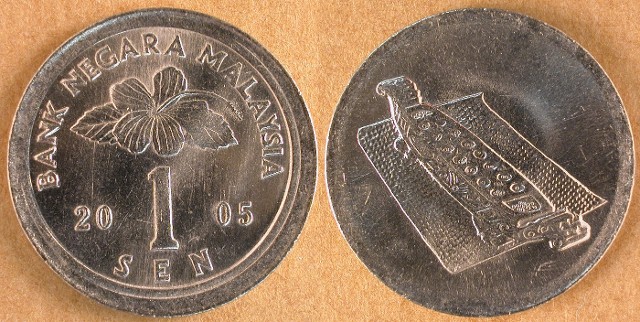
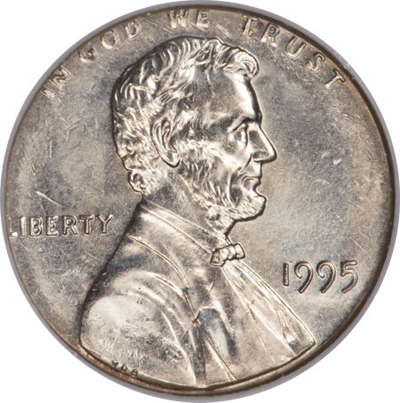
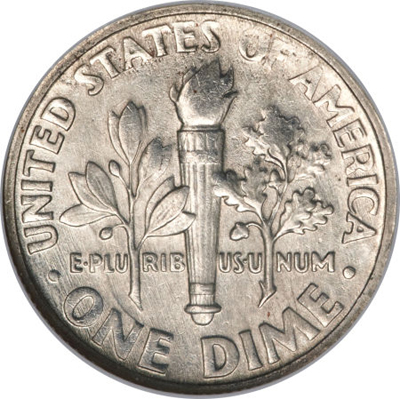
Mules Wrong Anvil Die 1993-D And 1999(P) Cent/Dime Mules
PART III. Die installation Errors:
Mules:
Wrong anvil die
Definition: Mules are coins struck by mismatched dies. In this case the wrong anvil die was installed in a coin press.
This Malaysian 10 sen mule was struck on a 10 sen planchet in a reeded 10 sen collar and carries a normal 10 sen obverse. The reverse face was struck by a 1 sen reverse (anvil) die.
This dual denomination mule was struck in 1993 by the Denver mint. It had the correct hammer die (cent die) and the coin was struck on the correct planchet. However, the anvil die (dime die) was mistakenly installed in the coin press which resulted in this unique combination.
Images courtesy of Heritage Auctions.
This dual denomination mule coin was struck in 1999 by the Philadelphia mint. It had the correct hammer die (cent die) and the coin was struck on the correct planchet. However, the anvil die (dime die) was mistakenly installed in the coin press which resulted in this unique combination.
Images courtesy of Heritage Auctions
Foreign Denomination Struck On A U S Planchet
PART V. Planchet Errors:
Wrong Planchet and Off-Metal Errors:
Foreign Denomination struck on a U. S. planchet.
Definition: Through most of its history the U.S. Mint has struck coins for other countries. Occasionally a domestic planchet would pass through a coinage press striking coins for another country.
Foreign denominations can also be struck on domestic planchets when a foreign mint has been contracted to supply planchets to the U.S. Mint. Canada has occasionally supplied nickel planchets to the U.S. Mint and so we sometimes find Canadian coins struck on these nickel planchets.
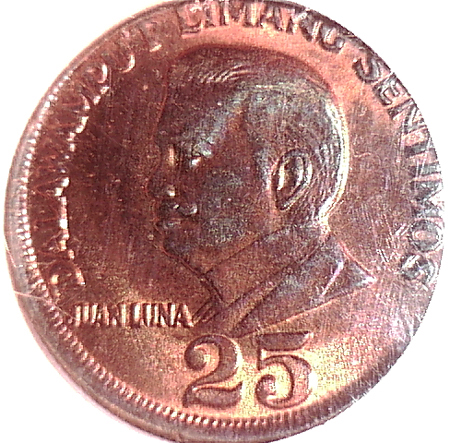
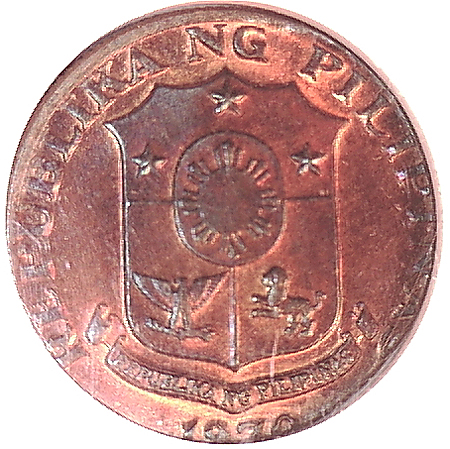
The 1970 Philippines 25 sentimos shown above was struck in the U.S. Mint on a domestic cent planchet. In 1970 the Denver and San Francisco Mints each struck 20 million 25 sentimos coins for the Philippines government.
This coin is in the collection of Jim Zimmerman.
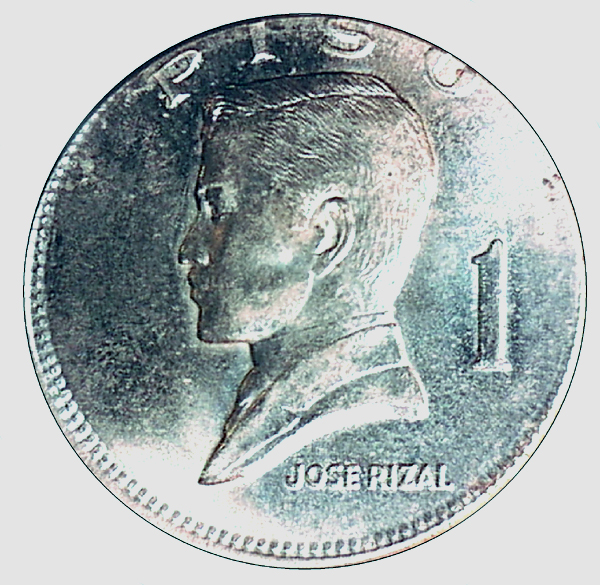
The 1972 Philippines 1 Peso shown above was struck in the U.S. Mint on a domestic clad 50 cent planchet. In 1972 the Denver Mint struck just under 122 million, 1 Peso coins for the Philippines government.
This coin is in the collection of Jim Zimmerman.
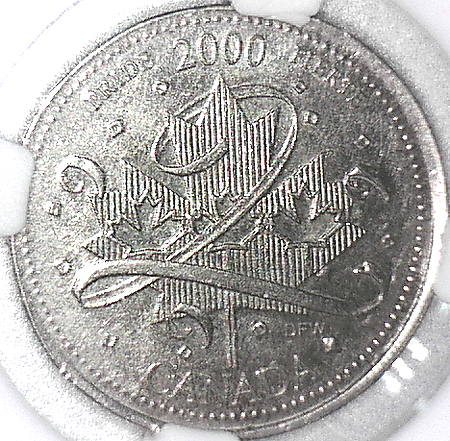
In 2000 the Royal Canadian Mint supplied the U.S. Mint with nickel planchets. One of these planchets, shown here, passed through a press striking the January, 2000 Canadian Millennium-series quarter dollar.
This coin is in the collection of Jim Zimmerman.
